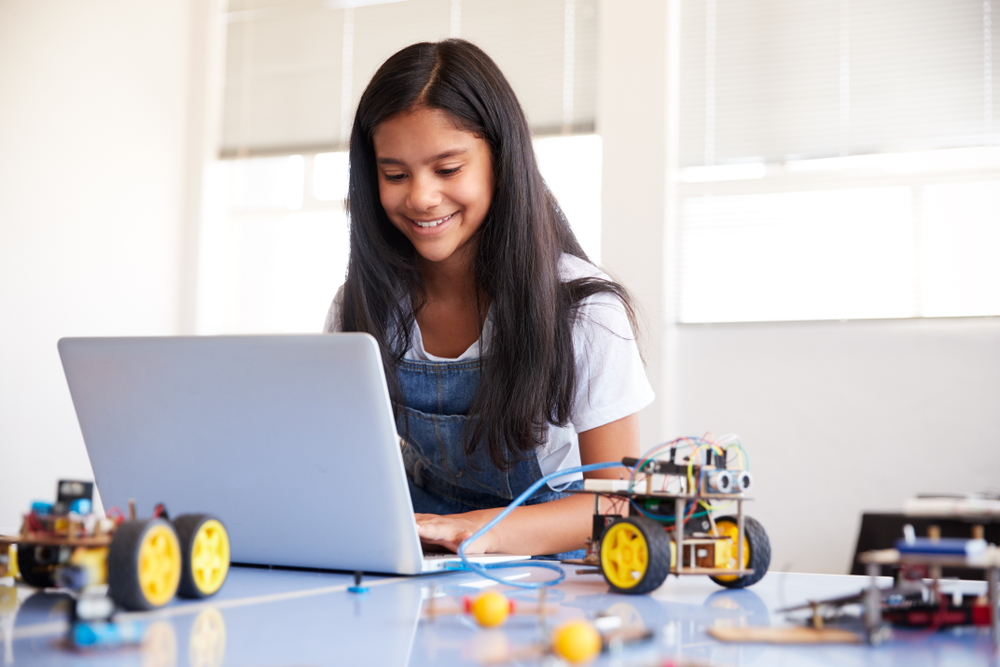For some schools and districts in the south, the first week of August marked the first days of school. We have the opportunity to learn from these schools and districts, as they’ve had to do what many are going to have to do in the future of distance learning.
And we have good news! While challenges and complexities abound, there were stories of really satisfied and happy parents! We are going to share 2 posts. In this post we will cover what the keys to success were from parents. In another post, we’ll cover some of the challenges families and students have experienced in the pursuit of effective distance learning.
Four Pieces of Good News
1- Parents and students WANT this to be successful. Whatever your “this” is, whether 100% distance learning or a hybrid model, parents and students are cheering for success. There were teachers sharing stories of students working for over 1 hour to log on to be with their class. One of our partner schools had consecutive attendance days of over 95% (which is good even in a normal year). Parents and students are leaning in to make this a success.
2 – Teachers are finding success. Teachers are finding that some of the things that made them successful in person also work remotely. A great curriculum and lesson plan, strong relationships with students, and ongoing feedback for students.
3 – There are ways to maximize success in advance. Now that we’ve seen schools and districts successfully launch the first week of school, via distance learning or in-person, we know that some keys to success no longer need to be a mystery. There are things that can create more opportunities for success.
4 – A bad day or class isn’t permanent. This is something teachers learn in their first days of teaching. Often the scariest part of being a first year teacher is the fear that a bad class is going to become a bad year. Luckily, most teachers find that a bad class can be just that – a bad class. Similarly, districts or schools are seeing that a challenging day or class isn’t a permanent state, and the opportunities to quickly get feedback, learn, change, and grow abound.
Now, what did we see in schools where parents and families were feeling very satisfied and happy with their experience?
Distance Learning: Keys to Success
Extensive and Detailed Preparation
Every school and district we saw had extensive and detailed preparation. Yet there are some additional levels of preparation, especially in a virtual classroom, that can help. For example, outside of computers, what are additional materials or tools students will need over the next month?
In addition to computers, a few of our partners also had other materials in their Grab and Go packs, such as:
-
- Individualized dry erase boards and pens
- Place Value blocks
- Rulers
- Graphic calculators
- Fiction or Non-fiction books they will read
- Class packets like they would be typically using in school
- Packs of pencils
- Spiraled notebooks
In addition to supplies they had multiple orientations.
They also were prepared with plans outside of academics, including:
- Plans for food pick up for families who needed it
- Plans for what would happen if someone within their school tested positive for COVID
- Plans for how they were going to support families with technology challenges
- Plans for how they were going to handle students who weren’t present the first 10 minutes of school
- Plans for how they were going to communicate with families whose most fluent language isn’t English
- Communication plans for sharing information with families and hearing from families at least weekly
- Expectations around virtual or in person learning
We know schools and districts don’t have unlimited time so can’t solve for every detail regarding distance learning. But it’s great to brainstorm all of the questions that might merit answers, so you can have a running list that you keep working towards resolving.
Also, one note on expectations setting. We find it most successful when schools or districts share not only the what – but the why. So if expectations around distance learning include students having their cameras on or being dressed a certain way, it is most helpful if families and teachers understand why you are doing this, and what wiggle room exists in extenuating circumstances.
Ongoing and Routine Communication
We talked a bit about this in the preparation section, but ongoing and routine communication is more important than ever.
Schools and districts are creating multiple methods to hear from and communicate to parents during distance learning. These include:
- A weekly and routine email or text cadence for outbound communication
- A weekly and routine system to collect parent feedback systematically, like Possip.
- A method for sharing academic information and communication with families (we’ve seen platforms like Schoology, Dean’s List, and pre-existing Parent Platforms.
- A method for a parent’s group to communicate with each other and help solve each other’s problems more real-time (this can be a Facebook group, Group Me, etc.)
In addition to these ongoing and routine communication systems, it is helpful for families to know who they should contact for what, and who the school will contact for what.
Practicing – for Families, Students, and Teachers
Practice really does ease anxieties for everyone. In this new context of distance learning and COVID schooling, everyone is a ‘rookie’ and we all can use a few extra “at-bats.” Teachers practicing their lessons ahead of time and scripting out their language is even more key when it comes to virtual teaching. There are fewer opportunities to read the classroom for any misunderstandings or lack clear teacher communication. Some schools are adding lesson execution practice time virtual PD, where teachers go in breakout rooms with a few other teachers and practice giving their lessons. Very rarely do we see first year teachers naturally pick up all of the new skills needed to be extremely effective without a lot of hard work and practice. Seeing that every teacher is really a “first year virtual teacher,” everyone can use some extra feedback and practice.
Families should also be practicing new at-home learning routines often. Some families are facilitating a “school day run-through” to make sure students can independently sign-on their technology, know when their classes are, understand any break times in their schedule, and start off the first day of virtual school on the right foot. The extra time on the front end is definitely worth it!
High Quality Curriculum
Having access to a high quality curriculum is an essential part of learning. There needs to be a consistent and equitable high quality curriculum for all students learning virtually. We saw in the spring the negative effects of low-quality curriculum and online instruction for low-income and minority students especially.
In order to do this, schools that have rolled out a high quality curriculum this fall have some kind of centralized curriculum that all students and teachers are following. The curriculum is also vetted by curriculum coordinators or other district experts on high-quality curriculum. One example of a district, Chicago Public Schools, created the Curriculum Equity Initiative to ensure that all students have access to a high quality curriculum during this time.
Sensible Schedules
At-home learning schedules can’t look like they did in the normal school day. Having students sitting on a computer screen from 8am-3pm just isn’t sensible. Developmentally, students need brain breaks in their day, lots of in-person human education, frequent movement, and time to be a kid. With all that in mind, schools that have seen success follow a few guidelines in creating their schedules:
1 hour of live teaching is too short. Kids need more than 1 hour of live teaching a day. They need connections with classmates and their teachers. Live classes increase engagement and motivation for students. Only one hour a day is not sufficient.
6 hours of back to back zoom is too long. On the other hand, kids also can’t sit for six hours straight in live classes. Schools should fall somewhere between 2-4 hours of live teaching throughout the day for students during at-home learning.
Build in lots of breaks. We all need breaks during the day, but kids especially need them. Both breaks in between classes and brain breaks within live zoom classes are necessary.
Here’s a Possip blog on creating schedules that avoid “Zoom Fatigue” for students.
Here are some guidelines and examples for creating schedules:
Great Teachers
My motto still to this day is “great teachers make great schools.” I believe that to my core and that still rings true for virtual schools. Great teachers make the big and small differences that leads to student success and growth. In this virtual climate, teachers are going above and beyond. Some teachers are available for communication around the clock and are fielding texts, emails, and phone calls constantly. On top of that, they are working to learn a whole new craft of teaching effectively online, executing high quality live lessons, and offering one-on-one office hours to students. We see schools thriving that have these great teachers. Along with great teachers, are communities and school administrators who frequently praise great teachers. We can all make sure that our great teachers feel appreciated, valued, and are constantly being praised for the quality of work and care for their students.
Live Teaching
As we mentioned earlier, live classes are necessary for students to feel engaged, connected, and confident during at-home virtual learning. Live teaching increases the amount of interactions students have during the day and allows them to get help in-the-moment when needed. In schools that are using live teaching, students feel more familiarity and satisfaction even though they are physically away from their teachers, friends, and normal school environment. Successful teachers have intentionally and creatively planned ways to build virtual classroom cultures during live instruction. They utilize the live teaching space to give students more feedback, build relationships through the chat feature and informal check-ins, and check for whole class understanding to inform future content. However, remember that there can be too-much live instruction. Keep it somewhere between 2-4 hours to allow students and teachers time to mentally break and prepare for their next live class time.
Carving Out Space for Connection and Relationship
Kids miss their teachers and friends desperately. Schools that are seeing virtual learning success are not only focusing on the academic part of school, but also the social-emotional part of school. These schools are working to create space for students to connect informally, build new relationships and grow existing relationships, and have fun together. Just like in a normal school day, students are involved with clubs, specials coursework, lunch groups, recess activities, and many other important social experiences. Schools that are intentionally thinking about providing opportunities for students to connect, talk to each other, and form relationships virtually are seeing success.
It’s also important for parents to feel connected and welcomed into the virtual school community. Schools that make families feel valued and listened to are seeing great virtual learning results. Here’s a blog on how to create a welcoming virtual school environment.
Starting Learning Immediately
Kids miss learning. Teachers miss teaching. Everyone is ready to get back at it and there is a lot to get caught up on. Don’t underestimate that kids want to learn immediately. Schools that had a successful start to virtual learning got started right away with learning. It shows that learning is going to be effective and that virtual school is going to get students where they need to be. Part of learning is also social-emotional learning (SEL). In order for students’ brains to be balanced and ready to be in learning mode, we need to ensure that students feel safe, listened to, and connected to others. Schools that have been successful acknowledge the trauma that students have gone through and that if a kid’s brain is worried about the basic need of survival being met, then they are not ready to be in learning or connection mode. Creating SEL lessons for students to build emotional regulation strategies and understand their emotions is a key to a successful fall.
Sweating the Small Stuff
Paying attention to the small stuff and taking feedback from teachers, families, and students has shown to bring virtual learning success. Small things can easily become big things if they aren’t addressed, especially during virtual learning when there can be more barriers to communication and observation. Teachers should be noticing if one student is not showing up to class and do everything they can to address difficulties they have coming to class. Schools should take feedback from parents about small issues, as well as the large feedback topics. Virtual schooling takes more attention to detail and more initiative from schools. This is a new experience for everyone and students can’t afford to lose any more learning time. Schools need to sweat the small stuff, be the best educators possible every day, and constantly grow and improve together.
To learn more about Possip or to talk techniques about distance learning, contact us today.





